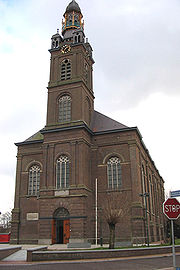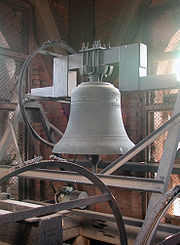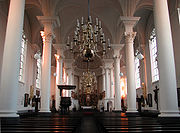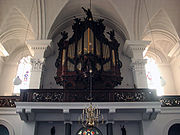
Erp (Netherlands)
Encyclopedia

Netherlands
The Netherlands is a constituent country of the Kingdom of the Netherlands, located mainly in North-West Europe and with several islands in the Caribbean. Mainland Netherlands borders the North Sea to the north and west, Belgium to the south, and Germany to the east, and shares maritime borders...
. It is located in the province of North Brabant
North Brabant
North Brabant , sometimes called Brabant, is a province of the Netherlands, located in the south of the country, bordered by Belgium in the south, the Meuse River in the north, Limburg in the east and Zeeland in the west.- History :...
, between Den Bosch and Eindhoven. Before 1994, the municipality
Municipality
A municipality is essentially an urban administrative division having corporate status and usually powers of self-government. It can also be used to mean the governing body of a municipality. A municipality is a general-purpose administrative subdivision, as opposed to a special-purpose district...
of Erp included the villages of Boerdonk
Boerdonk
Boerdonk is a small village in the municipality of Veghel, in North Brabant in the Netherlands. The village was part of the municipality of Erp until a municipal reorganization in 1994. As of January 2006 it has 794 residents.Community Centre...
and Keldonk. After that year, Erp and the two villages became part of the municipality
Municipality
A municipality is essentially an urban administrative division having corporate status and usually powers of self-government. It can also be used to mean the governing body of a municipality. A municipality is a general-purpose administrative subdivision, as opposed to a special-purpose district...
of Veghel
Veghel
Veghel is a municipality and a town in the southern Netherlands.Since 1994 Veghel and the neighbouring village of Erp have formed a single municipality.Veghel is twinned with Goch in Germany.- Population centres :*Boerdonk*Eerde*Erp*Keldonk...
due to government reorganization.
The municipality
Municipality
A municipality is essentially an urban administrative division having corporate status and usually powers of self-government. It can also be used to mean the governing body of a municipality. A municipality is a general-purpose administrative subdivision, as opposed to a special-purpose district...
of Veghel
Veghel
Veghel is a municipality and a town in the southern Netherlands.Since 1994 Veghel and the neighbouring village of Erp have formed a single municipality.Veghel is twinned with Goch in Germany.- Population centres :*Boerdonk*Eerde*Erp*Keldonk...
consists of Veghel
Veghel
Veghel is a municipality and a town in the southern Netherlands.Since 1994 Veghel and the neighbouring village of Erp have formed a single municipality.Veghel is twinned with Goch in Germany.- Population centres :*Boerdonk*Eerde*Erp*Keldonk...
, Erp, Boerdonk
Boerdonk
Boerdonk is a small village in the municipality of Veghel, in North Brabant in the Netherlands. The village was part of the municipality of Erp until a municipal reorganization in 1994. As of January 2006 it has 794 residents.Community Centre...
, Keldonk, Mariaheide, Zijtaart and Eerde. The town of Veghel
Veghel
Veghel is a municipality and a town in the southern Netherlands.Since 1994 Veghel and the neighbouring village of Erp have formed a single municipality.Veghel is twinned with Goch in Germany.- Population centres :*Boerdonk*Eerde*Erp*Keldonk...
is located a mere 3 miles northwest of Erp and other neighboring towns include Uden
Uden
Uden is a municipality and a town in the province of Noord-Brabant, Netherlands.- History :Uden was first recorded around 1190 as “Uthen”. However, earlier settlements have been found in the areas of the modern day Moleneind, Vorstenburg and Bitswijk and evidence of ice-age settlements has been...
(north), Boekel
Boekel
Boekel is a municipality and a town in the southern Netherlands.-External links:**...
(east), Gemert
Gemert
Gemert is a town in the Dutch province of North Brabant. It is located in the municipality of Gemert-Bakel. On January 1, 2009 there were 15.268 inhabitants in Gemert.Gemert was a separate municipality until 1997, when it merged with Bakel....
(southeast), Beek en Donk
Beek en Donk
Beek en Donk is a village in the province Noord Brabant, Netherlands. There are 10028 inhabitants.The area of nowadays Beek en Donk has been inhabited for a long time. Tools of stone age nomadic people have been found. The first permanent inhabitants come around 700 AD.In the Middle Ages, the basis...
(south), and Sint-Oedenrode
Sint-Oedenrode
Sint-Oedenrode is a municipality and a city in the South of the Netherlands.-History of the city of Sint-Oedenrode:First records of the settlement called Rhode date from the year 500. Sint-Oedenrode was a small settlement on an elevated place near the river Dommel...
(west).
The town hall of Erp dates from 1791. It lost its main function when Erp was annexed to the municipality
Municipality
A municipality is essentially an urban administrative division having corporate status and usually powers of self-government. It can also be used to mean the governing body of a municipality. A municipality is a general-purpose administrative subdivision, as opposed to a special-purpose district...
of Veghel
Veghel
Veghel is a municipality and a town in the southern Netherlands.Since 1994 Veghel and the neighbouring village of Erp have formed a single municipality.Veghel is twinned with Goch in Germany.- Population centres :*Boerdonk*Eerde*Erp*Keldonk...
in 1994. Both the town hall and the Saint Servatius Church are on the national list of historic preservation.
The old municipality
Municipality
A municipality is essentially an urban administrative division having corporate status and usually powers of self-government. It can also be used to mean the governing body of a municipality. A municipality is a general-purpose administrative subdivision, as opposed to a special-purpose district...
of Erp included the villages of Boerdonk
Boerdonk
Boerdonk is a small village in the municipality of Veghel, in North Brabant in the Netherlands. The village was part of the municipality of Erp until a municipal reorganization in 1994. As of January 2006 it has 794 residents.Community Centre...
and Keldonk. This area inhabits about 6,000 residents. The current municipality
Municipality
A municipality is essentially an urban administrative division having corporate status and usually powers of self-government. It can also be used to mean the governing body of a municipality. A municipality is a general-purpose administrative subdivision, as opposed to a special-purpose district...
of Veghel
Veghel
Veghel is a municipality and a town in the southern Netherlands.Since 1994 Veghel and the neighbouring village of Erp have formed a single municipality.Veghel is twinned with Goch in Germany.- Population centres :*Boerdonk*Eerde*Erp*Keldonk...
, with Erp included, counts almost 37,000 residents.
History
The earliest traces of habitation in Erp and its immediate surroundings are found on the town’s southeast side, on the road to GemertGemert
Gemert is a town in the Dutch province of North Brabant. It is located in the municipality of Gemert-Bakel. On January 1, 2009 there were 15.268 inhabitants in Gemert.Gemert was a separate municipality until 1997, when it merged with Bakel....
near the Aa River
Aa River
Aa River may refer to:* Aa River , a river in northern France* Aa River , a river in North Brabant, Netherlands* Aa of Weerijs, a river in North Brabant, Netherlands* Drentsche Aa, a river in Groningen, Netherlands...
. According to A. Meuwese, local farmers found several funerary vessels from around 300 B.C. in the early 20th century. Gallic tribes that inhabited the region placed the ashes and remains of their deceased in these vessels and buried them in the many funerary fields.
Some funerary fields were located in this particular area and A. Meuwese mentions that a small “heathen” temple supposedly stood at a past bend in the Aa River
Aa River (Meuse)
The Aa is a small river in The Netherlands. It rises near Meijel in the southeastern province of Limburg, in the Peel region. It flows northwest through the province of North Brabant towards 's-Hertogenbosch, roughly along the Zuid-Willemsvaart canal. In 's-Hertogenbosch, at the confluence of the...
, but it had been swallowed by the river. The story goes that on Christmas night, one can hear church bells ring at this location. Similar stories have been reported near other funerary fields.
In addition to Gallic
Gauls
The Gauls were a Celtic people living in Gaul, the region roughly corresponding to what is now France, Belgium, Switzerland and Northern Italy, from the Iron Age through the Roman period. They mostly spoke the Continental Celtic language called Gaulish....
pottery, traces of Roman pottery were found. The Roman items are of a later period than the Gallic
Gauls
The Gauls were a Celtic people living in Gaul, the region roughly corresponding to what is now France, Belgium, Switzerland and Northern Italy, from the Iron Age through the Roman period. They mostly spoke the Continental Celtic language called Gaulish....
and are recognizable by their thickness and curled edges.
The area around Erp was inhabited by the Menapii
Menapii
The Menapii were a Belgic tribe of northern Gaul in pre-Roman and Roman times. Their territory according to Strabo, Caesar and Ptolemy stretched from the mouth of the Rhine in the north, and southwards along the west of the Schelde. Their civitas under the Roman empire was Cassel , near Thérouanne...
tribe, who roamed the area south of the Rhine River, north of the Ardennes
Ardennes
The Ardennes is a region of extensive forests, rolling hills and ridges formed within the Givetian Ardennes mountain range, primarily in Belgium and Luxembourg, but stretching into France , and geologically into the Eifel...
and the Morini
Morini
The Morini were a Belgic tribe in the time of the Roman Empire. We know little about their language but one of their cities, Boulogne-sur-Mer was called Bononia by Zosimus and Bonen in the Middle Ages. Zosimus mentioned the Low Germanic character of the city...
tribe, north and west of the Eburones
Eburones
The Eburones , were a Belgic people who lived in the northeast of Gaul, near the river Meuse and the modern provinces of Belgian and Dutch Limburg, in the period immediately before it was conquered by Rome. They played a major role in Julius Caesar's account of his "Gallic Wars", as the most...
tribe, west of the Meuse River
Meuse River
The Maas or Meuse is a major European river, rising in France and flowing through Belgium and the Netherlands before draining into the North Sea...
, and east of the North Sea
North Sea
In the southwest, beyond the Straits of Dover, the North Sea becomes the English Channel connecting to the Atlantic Ocean. In the east, it connects to the Baltic Sea via the Skagerrak and Kattegat, narrow straits that separate Denmark from Norway and Sweden respectively...
.
Erp is mentioned since the 12th century, as property of a noble family. In earlier records, dating from 1134, Erthepe is mentioned and it is assumed that this is Erp. The first priest in the parish is mentioned in 1360. During this era, Erp was part of the Duchy of Brabant
Duchy of Brabant
The Duchy of Brabant was a historical region in the Low Countries. Its territory consisted essentially of the three modern-day Belgian provinces of Flemish Brabant, Walloon Brabant and Antwerp, the Brussels-Capital Region and most of the present-day Dutch province of North Brabant.The Flag of...
.
In 1579, seven Northern Dutch provinces declared their independence, while Brabant remained part of the Spain
Spain
Spain , officially the Kingdom of Spain languages]] under the European Charter for Regional or Minority Languages. In each of these, Spain's official name is as follows:;;;;;;), is a country and member state of the European Union located in southwestern Europe on the Iberian Peninsula...
of Philip II
Philip II of Spain
Philip II was King of Spain, Portugal, Naples, Sicily, and, while married to Mary I, King of England and Ireland. He was lord of the Seventeen Provinces from 1556 until 1581, holding various titles for the individual territories such as duke or count....
, son of Holy Roman Emperor
Holy Roman Emperor
The Holy Roman Emperor is a term used by historians to denote a medieval ruler who, as German King, had also received the title of "Emperor of the Romans" from the Pope...
Charles V
Charles V, Holy Roman Emperor
Charles V was ruler of the Holy Roman Empire from 1519 and, as Charles I, of the Spanish Empire from 1516 until his voluntary retirement and abdication in favor of his younger brother Ferdinand I and his son Philip II in 1556.As...
.
In 1648, the Peace of Westphalia
Peace of Westphalia
The Peace of Westphalia was a series of peace treaties signed between May and October of 1648 in Osnabrück and Münster. These treaties ended the Thirty Years' War in the Holy Roman Empire, and the Eighty Years' War between Spain and the Dutch Republic, with Spain formally recognizing the...
, concluded the Eighty Years' War (Tachtigjarige Oorlog) of the Northern Dutch provinces against the Habsburgs. Brabant was separated and the current North Brabant
North Brabant
North Brabant , sometimes called Brabant, is a province of the Netherlands, located in the south of the country, bordered by Belgium in the south, the Meuse River in the north, Limburg in the east and Zeeland in the west.- History :...
was incorporated in the newly established, independent country of the Netherlands
Netherlands
The Netherlands is a constituent country of the Kingdom of the Netherlands, located mainly in North-West Europe and with several islands in the Caribbean. Mainland Netherlands borders the North Sea to the north and west, Belgium to the south, and Germany to the east, and shares maritime borders...
, while the larger southern parts of Antwerp and Brabant remained under Spanish Habsburg rule until 1713.
After the ravage of the French Revolution
French Revolution
The French Revolution , sometimes distinguished as the 'Great French Revolution' , was a period of radical social and political upheaval in France and Europe. The absolute monarchy that had ruled France for centuries collapsed in three years...
and Napoleonic Europe, at the Congress of Vienna
Congress of Vienna
The Congress of Vienna was a conference of ambassadors of European states chaired by Klemens Wenzel von Metternich, and held in Vienna from September, 1814 to June, 1815. The objective of the Congress was to settle the many issues arising from the French Revolutionary Wars, the Napoleonic Wars,...
in 1815, Brabant was reunited in the newly established Kingdom of the Netherlands
Kingdom of the Netherlands
The Kingdom of the Netherlands is a sovereign state and constitutional monarchy with territory in Western Europe and in the Caribbean. The four parts of the Kingdom—Aruba, Curaçao, the Netherlands, and Sint Maarten—are referred to as "countries", and participate on a basis of equality...
. This only lasted until 1830, when Belgium
Belgium
Belgium , officially the Kingdom of Belgium, is a federal state in Western Europe. It is a founding member of the European Union and hosts the EU's headquarters, and those of several other major international organisations such as NATO.Belgium is also a member of, or affiliated to, many...
declared their independence from the Netherlands and Brabant was divided between the two countries.
In 1940 Erp was occupied by German
Nazi Germany
Nazi Germany , also known as the Third Reich , but officially called German Reich from 1933 to 1943 and Greater German Reich from 26 June 1943 onward, is the name commonly used to refer to the state of Germany from 1933 to 1945, when it was a totalitarian dictatorship ruled by...
troops. In 1944, paratroopers participating in the largest airborne operation in history Operation Market Garden
Operation Market Garden
Operation Market Garden was an unsuccessful Allied military operation, fought in the Netherlands and Germany in the Second World War. It was the largest airborne operation up to that time....
liberated Erp and its surroundings. The liberated strip from Eindhoven to Arnhem was later nicknamed Hell's Highway
Operation Market Garden
Operation Market Garden was an unsuccessful Allied military operation, fought in the Netherlands and Germany in the Second World War. It was the largest airborne operation up to that time....
.
Saint Servatius Church


There are two known drawings of the old Saint Servatius Church: a somewhat romanticized pen drawing by the hand of Hendrik Spilman (1721–1784); and a sketch dated September 13, 1788 by the hand of architect Hendrik Verhees (1744–1813), who designed the town hall of Erp in 1791.
In the fifteenth and sixteenth century, simple masonry churches with a nave and two aisles were built in a regional variant of the late-Gothic style throughout the Campine. Judging from the drawings, the church in Erp shares many characteristics of this Campine Gothic style, which appears in a sense rural without its use of the elaborate Gothic decorations as seen in northern France. The most characteristic element of these Campine Gothic churches is the monumental brick bell tower or steeple with heavy-set diagonal buttresses on all four corners, examples of which can still be found throughout the region.
During the Napoleonic era, the Church was handed back to the Catholics, but only after a fierce dispute with the Protestants living in Erp.
The current Saint Servatius Church was finished in 1844 and is a so-called waterstaat church, designed by architect Arnoldus van Veggel in a neo-Classical style. The spire of the steeple was designed by famous architect Pierre Cuypers
Pierre Cuypers
Petrus Josephus Hubertus Cuypers was a Dutch architect. His name is most frequently associated with the Amsterdam Central Station and the Rijksmuseum , both in Amsterdam. More representative for his oeuvre, however, are numerous churches, of which he designed more than 100...
, after the original was destroyed by a fire caused by lightning in 1895. Cuypers also redesigned the interior around 1880. From then, the interior took after the neo-Gothic style and was painted with biblical scenes.



Historic Sites
The following buildings are marked for historic preservation (‘rijksmonument’) by the Dutch government:- Town Hall. Built in brick in 1791 by Dutch architect Hendrik Verhees (1744–1813). It currently houses Erthepe, the local historical society.
- Saint Servatius Church
- Two 19th-century houses at Hezelstraat 23 and Kerkstraat 31.
- Four farms at Molentiend 2 en 4 (dates from 1898); Morschehoef 16 (18th-century); Morschehoef 19 (19th-century); and Voorbolst 5 (18th-century).
The Mills of Erp
Erp had several mills throughout the centuries, but all disappeared before the 1960s.- The oldest windmill, a tower millTower millA tower mill is a type of windmill which consists of a brick or stone tower, on top of which sits a roof or cap which can be turned to bring the sails into the wind....
at the Watermolenweg, was heavily damaged in a storm in 1949 and subsequently demolished five years later. It was built in 1849 to replace a post millPost millThe post mill is the earliest type of European windmill. The defining feature is that the whole body of the mill that houses the machinery is mounted on a single vertical post, around which it can be turned to bring the sails into the wind. The earliest post mills in England are thought to have...
that was already mentioned in documents in 1540 and served to complement the watermill on the river Aa. The watermill was demolished in 1897. - The windmill at the Molentiend was built in 1866. This smock millSmock millThe smock mill is a type of windmill that consists of a sloping, horizontally weatherboarded tower, usually with six or eight sides. It is topped with a roof or cap that rotates to bring the sails into the wind...
was demolished in 1954, but the miller’s house still remains. - A stone smock mill, called “De Nijverheid,” was built in 1898 at the Cruijgenstraat. Even though the mill was not damaged or neglected, it was demolished around 1959.
johanna Elisabeth Maria vanBerlo and Marianus Josephus Bos wer married in this church. They moved to Canada in 1980. They have 4 children.
People
Henricus Herp was born in the early 15th century in Erp. He was an influential theological writer and his most famous work is Spieghel der Volcomenheit. He died in the late 15th century in MechelenMechelen
Mechelen Footnote: Mechelen became known in English as 'Mechlin' from which the adjective 'Mechlinian' is derived...
, Belgium
Belgium
Belgium , officially the Kingdom of Belgium, is a federal state in Western Europe. It is a founding member of the European Union and hosts the EU's headquarters, and those of several other major international organisations such as NATO.Belgium is also a member of, or affiliated to, many...
.
Anky van Grunsven
Anky van Grunsven
Theodora Elisabeth Gerarda van Grunsven is a Dutch dressage champion who won the gold medal in the 2000 Olympics with her horse Bonfire and gold in the 2004 Olympics and in the 2008 Olympics with Salinero.Van Grunsven has also dominated World Cup Dressage competition, being named the World...
was born January 2, 1968 in Erp and recently moved back. She is a Dutch dressage
Dressage
Dressage is a competitive equestrian sport, defined by the International Equestrian Federation as "the highest expression of horse training." Competitions are held at all levels from amateur to the World Equestrian Games...
champion who won two gold medals in the 2000 and 2004 summer Olympics
Olympic Games
The Olympic Games is a major international event featuring summer and winter sports, in which thousands of athletes participate in a variety of competitions. The Olympic Games have come to be regarded as the world’s foremost sports competition where more than 200 nations participate...
and four silver medals in the 1992, 1996 and 2000 summer Olympics
Olympic Games
The Olympic Games is a major international event featuring summer and winter sports, in which thousands of athletes participate in a variety of competitions. The Olympic Games have come to be regarded as the world’s foremost sports competition where more than 200 nations participate...
.
Sources
- Meuwese, A.P.M. Dr. Erp; Gemeente en Parochie, ’s Hertogenbosch: Zuid-Nederlandsche Drukkerij N.V., 1955
- Brabants Historisch Informatie Centrum

